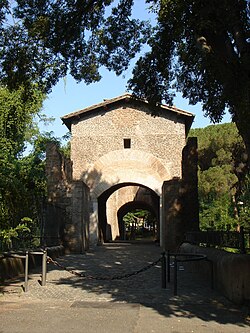Ponte Nomentano
Ponte Nomentano (Pons Lamentanus) | |
|---|---|
 | |
| Coordinates | 41°56′01″N 12°31′57″E / 41.933611°N 12.5325°E |
| Carries | Via Nomentana |
| Crosses | Aniene |
| Locale | Rome, Italy |
| Characteristics | |
| Design | Fortified arch bridge |
| Material | Stone (incl. travertine), brick |
| Total length | 60 m |
| Width | 7.35 m |
| Longest span | 15 m |
| No. of spans | 3 |
| History | |
| Construction end | Probably 1st century BC |
| Location | |
 | |
The Ponte Nomentano (called Pons Lamentanus during the
History


In
The lower part of the bridge tower dates, according to an unproven tradition, from the time of Pope Adrian I (772–795). The imposing castle-like structure was constructed during a general overhaul of the bridge by Pope Nicholas V (1447–1455), after which minor repairs followed in 1461, 1470, and 1474.[1]
A view of the bridge was painted by English artist Joseph Wright of Derby in the 1770s.[4] The painting was later badly overpainted,[5] and it languished in the Derby Museum until it was rediscovered and restored in 2017, as documented by the television series Britain's Lost Masterpieces (series 2, episode 2).[6]
In 1849, French troops cut the bridge by 7 m to check Garibaldi's advance on Rome, but it was soon restored.[7]
Today, the bridge is surrounded by a park, well within the municipal limits of Rome, and restricted to pedestrians.
Structure
The 31.30-meter-long superstructure of the Ponte Nomentano has, in essence, preserved its medieval character, while the dimensions of the bridge, which measure 60 m in overall length and 7.35 m in width, have remained practically unchanged since antiquity.[8] The 15-meter-wide central arch clearly dates back to ancient times, it is presumed from the late Republic or early Augustan Principate, as indicated by its semi-circular shape and the execution of the travertine stonework.[9] Apart from this, only some further layers of travertine in the retaining walls can be assigned with certainty to the Roman period.[9] The two lateral brick arches were built in the reign of Pope Innocent X (1644–1655) in lieu of stone vaults.[1]
Further examples for fortified bridges across the Aniene include the Roman
Gallery
-
Painting of the Ponte Nomentano around 1837
-
During 2008 flood
-
Medieval bridge tower
-
Passageway
See also
- List of Roman bridges
- Roman architecture
- Roman engineering
References
- ^ a b c Galliazzo 1994, p. 37
- ^ Procopius: De Bello Gothico, 3.24
- ^ Galliazzo 1994, pp. 37, 39
- ^ "A View of the Ponte Nomentano, near Rome". Art UK. Retrieved 2021-10-01.
- ^ "View of the Ponte Nomentano, by Joseph Wright of Derby". Derby Museums. Retrieved 2021-10-01.
- ^ Grovesnor, Bender. "Britain's Lost Masterpieces 2/2". BBC iplayer. BBC. Retrieved 5 October 2017.
- ^ Galliazzo 1994, pp. 37–38
- ^ Galliazzo 1994, pp. 38–39
- ^ a b Galliazzo 1994, p. 39
- ^ O’Connor 1993, p. 68
Sources
- Galliazzo, Vittorio (1994), I ponti romani. Catalogo generale, vol. 2, Treviso: Edizioni Canova, pp. 37–39 (No. 21), ISBN 88-85066-66-6
- O’Connor, Colin (1993), Roman Bridges, Cambridge University Press, p. 68 (I15), ISBN 0-521-39326-4
External links
- Illustrated article at Romeartlover
- Ponte Nomentano at Structurae





